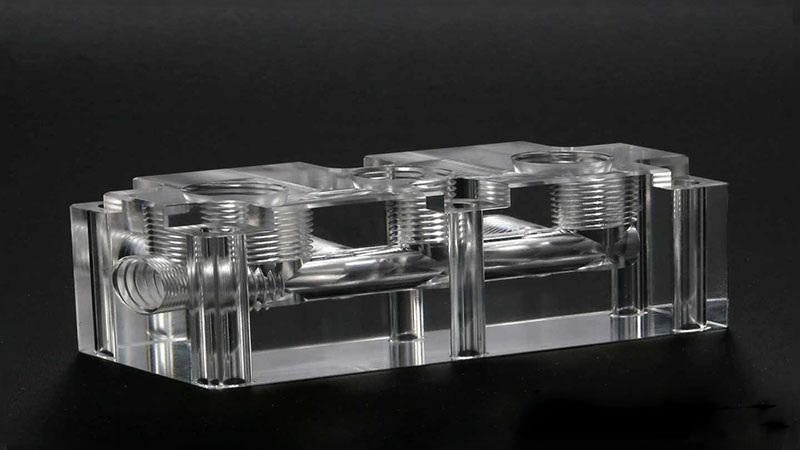In the field of mechanical parts processing and precision machining, product designers across various industries frequently choose plastic polymers for manufacturing non-standard components. PC (polycarbonate) and PMMA (acrylic) are two widely used materials, especially in the production of optical and transparent components. However, selecting between PC and acrylic for a project can be challenging due to their distinct properties. A thorough understanding of these materials’ unique attributes is essential for determining which best suits specific product requirements. This article explores the differences between machining acrylic and PC, covering aspects such as material characteristics, applications, and surface treatment.
1. Differences Between PC and PMMA (Acrylic)
To better understand the differences in processing acrylic and PC materials, let’s examine their distinct properties.
1.1 Material Properties and Applications
Properties and Applications of PC
Transparent PC boasts a high light transmission rate of up to 88%, offering excellent visibility for machined parts. In mechanical and precision machining, PC stands out due to its high stress resistance and superior impact strength, making it an ideal choice for non-standard components requiring robust material performance. However, PC has moderate weather resistance and poor UV resistance.
PC is widely used in the manufacture of electrical and electronic devices, safety equipment, automotive parts, office equipment, and outdoor signage. In precision machining, product engineers frequently utilize PC to produce transparent structural components or optical parts. Properties and Applications of PMMA (Acrylic)
Transparent acrylic has outstanding optical clarity, with a precise light transmittance of 92%, ensuring excellent visibility. It is one of the best hydrolysis-resistant and non-yellowing plastics, offering superior weather resistance. When UV stabilizers are added, its UV resistance improves significantly, and it remains stable within a temperature range of 40–80°C. However, acrylic has a lower melting point and poor heat resistance, making it prone to deformation at relatively low temperatures.
Although PMMA is relatively brittle, its exceptional optical performance, light transmittance, and weather resistance make it widely used across various industries, including the automotive sector, where high optical quality is required for lighting components. In mechanical and non-standard component machining, acrylic is commonly used for aquarium tanks, displays, signage, picture frames, architectural features, and decorative components.
1.2 Machining and Surface Treatment
Machining PC and Surface Treatment Considerations
Transparent PC is a tough and impact-resistant material with excellent strength, making its machining process relatively time-consuming. Milling machines, drilling machines, or lathes can be used for machining PC parts. Additionally, PC can be disassembled and re-bonded into different shapes. In terms of surface treatment, PC products are more suitable for painting or vacuum coating but cannot be electroplated.
Since PC has a low melting point, special attention must be paid during CNC machining to prevent excessive heat buildup. Machined PC surfaces typically appear semi-transparent, and manual polishing alone cannot achieve full transparency. Therefore, for high optical clarity requirements, vapor polishing is recommended. This method enhances the transparency of PC components effectively.
Machining PMMA and Surface Treatment Considerations
Since transparent PMMA (acrylic) is brittle, extra care is required during machining. In precision machining and CNC processing of acrylic, sharp cutting tools must be used to prevent excessive heat buildup, as the material has a low melting point.
Acrylic naturally has excellent optical clarity, and additional polishing can further enhance its transparency. Techniques such as coating or flame polishing can be used to protect machined acrylic surfaces from scratches. However, post-processing steps like grinding and polishing will extend the overall production cycle.

1.3 Differences in the Polishing Process
Although PC and acrylic follow similar pre-polishing steps in plastic machining, their polishing processes differ significantly.
Polishing PC
When polishing PC plastic, fine sandpaper is used for wet sanding to remove deep scratches and achieve a smooth surface. Vapor polishing is an ideal method for polishing PC parts, as it not only enhances their physical properties but also improves the transparency of small features and interior/exterior surfaces. Vapor polishing results in a smooth and clear surface finish. Additionally, specialized PC polishing compounds or plastic polishes can further refine the surface and enhance clarity.
Polishing PMMA (Acrylic)
For components requiring high optical quality, manual polishing is the best method for treating machined PMMA (acrylic) parts. However, before polishing transparent acrylic, it is crucial to clean its surface. The process involves using coarse abrasives first, followed by finer abrasives, and applying polishing compounds with cloth, polishing wheels, or pads. With this treatment, finished acrylic products achieve a scratch-free, high-quality optical surface.
2. Choosing Between PC and Acrylic for Your Project
Understanding the differences in machining PC and acrylic helps determine the most suitable material for specific applications. Here are key factors to consider when making a decision:
2.1 For High Surface Finish and Superior Optical Clarity
If high surface finish and excellent visibility are top priorities, acrylic is the best choice due to its superior light transmittance and transparency. However, in mechanical and non-standard component machining, it is important to note that acrylic is prone to cracking under high stress or impact. Additionally, PMMA parts can degrade when exposed to prolonged UV radiation. For outdoor applications, using UV stabilizers is advisable.
2.2 When High Impact Resistance is Required
While acrylic offers higher light transmittance, PC provides superior impact resistance and a broader operating temperature range. Therefore, when strength and low-temperature resistance are crucial, PC is the preferred option.
2.3 For High Heat Resistance
PC is more ductile and easier to machine and form than acrylic. It also offers better heat resistance. However, acrylic has better chemical and solvent resistance than PC. It is important to consider factors such as material type, polishing techniques, surface roughness, and available equipment, as these will affect the final surface quality of the product. Evaluating these differences is essential in choosing the right material for your specific needs.
3. High-Quality PC and PMMA Components from Litega
Litega is a professional supplier of plastic CNC machining services, specializing in producing high-quality, high-precision PC and PMMA components. In the fields of precision machining, mechanical parts processing, and non-standard component fabrication, our expert engineers and machinists bring extensive knowledge and experience to manufacturing top-tier parts from engineering plastics like acrylic and PC.
We offer a full range of manufacturing capabilities, including CNC machining, 3D printing, precision sheet metal fabrication, and rapid prototyping. These advantages allow us to meet the unique demands of our clients, ensuring strict tolerances and superior surface finishes. If you have any requirements, feel free to contact us. We provide fast turnaround times and competitive pricing for prototype development and part production.
Conclusion
Both PC and acrylic offer distinct advantages in different applications, making them ideal alternatives to glass. This article has provided an in-depth comparison of these two materials in terms of properties, applications, machining, and surface treatment options. However, the final choice of material should ultimately be based on specific product requirements.



